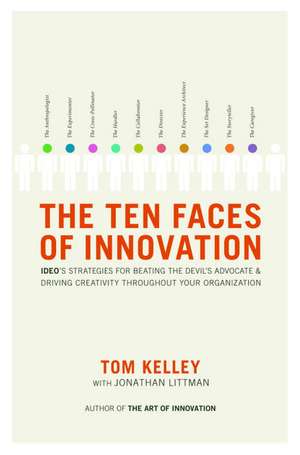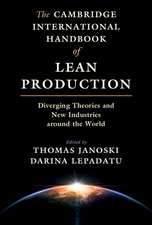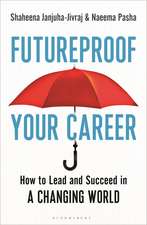The Ten Faces of Innovation: Ideo's Strategies for Beating the Devil's Advocate & Driving Creativity Throughout Your Organization
Autor Thomas Kelley Jonathan Littmanen Limba Engleză Hardback – 30 sep 2005
The role of the devil's advocate is nearly universal in business today. It allows individuals to step outside themselves and raise questions and concerns that effectively kill new projects and ideas, while claiming no personal responsibility. Nothing is more potent in stifling innovation.
Drawing on nearly 20 years of experience managing IDEO, Kelley identifies ten roles people can play in an organization to foster innovation and new ideas while offering an effective counter to naysayers. Among these approaches are the Anthropologist—the person who goes into the field to see how customers use and respond to products, to come up with new innovations; the Cross-pollinator who mixes and matches ideas, people, and technology to create new ideas that can drive growth; and the Hurdler, who instantly looks for ways to overcome the limits and challenges to any situation.
Filled with engaging stories of how companies like Kraft, Procter and Gamble, Cargill and Samsung have incorporated IDEO's thinking to transform the customer experience, THE TEN FACES OF INNOVATION is an extraordinary guide to nurturing and sustaining a culture of continuous innovation and renewal.
Preț: 212.29 lei
Nou
Puncte Express: 318
Preț estimativ în valută:
40.63€ • 44.11$ • 34.13£
40.63€ • 44.11$ • 34.13£
Carte disponibilă
Livrare economică 01-15 aprilie
Preluare comenzi: 021 569.72.76
Specificații
ISBN-13: 9780385512077
ISBN-10: 0385512074
Pagini: 273
Ilustrații: 16 COLOR PHOTOS AS CHAPTER HEADERS
Dimensiuni: 155 x 236 x 25 mm
Greutate: 0.73 kg
Editura: Broadway Business
ISBN-10: 0385512074
Pagini: 273
Ilustrații: 16 COLOR PHOTOS AS CHAPTER HEADERS
Dimensiuni: 155 x 236 x 25 mm
Greutate: 0.73 kg
Editura: Broadway Business
Recenzii
Advance Praise for The Ten Faces of Innovation
"Essential reading for every single person in your organization--even the CEO should read it! Each page contains a nugget that's worth the price of the entire book. Wow."
—Seth Godin, author of Purple Cow
“A concensus is emerging that Innovation must become most every firm's ‘Job One.’ ‘Hurdle One,’ however, is a doozer: establishing a Culture of Innovation. IDEO thought leader Tom Kelley offers a thoroughly original and thoroughly tested approach to creating that ‘culture of innovation.’ Rigorously applying his ‘Ten Faces’ will get the innovation ball rolling ... fast. Bravo!”
— Tom Peters
Critical Acclaim for Tom Kelley’s Previous National Bestseller The Art of Innovation
“Tom Kelley has unlocked the magic box of innovation for corporate America.”
—Bruce Nussbaum, BusinessWeek
“In light of all the books on the market about creativity, it takes a certain amount of chutzpah to call your book The Art of Innovation. Yet Kelley makes a good case.... Practical, clearly written, and highly detailed.”
—USA Today
“On nearly every page, the story of some upstart invention is recounted in patter that's as good as a skilled magician's…. Almost like visiting an IDEO workshop in person.”
—Wired
"Essential reading for every single person in your organization--even the CEO should read it! Each page contains a nugget that's worth the price of the entire book. Wow."
—Seth Godin, author of Purple Cow
“A concensus is emerging that Innovation must become most every firm's ‘Job One.’ ‘Hurdle One,’ however, is a doozer: establishing a Culture of Innovation. IDEO thought leader Tom Kelley offers a thoroughly original and thoroughly tested approach to creating that ‘culture of innovation.’ Rigorously applying his ‘Ten Faces’ will get the innovation ball rolling ... fast. Bravo!”
— Tom Peters
Critical Acclaim for Tom Kelley’s Previous National Bestseller The Art of Innovation
“Tom Kelley has unlocked the magic box of innovation for corporate America.”
—Bruce Nussbaum, BusinessWeek
“In light of all the books on the market about creativity, it takes a certain amount of chutzpah to call your book The Art of Innovation. Yet Kelley makes a good case.... Practical, clearly written, and highly detailed.”
—USA Today
“On nearly every page, the story of some upstart invention is recounted in patter that's as good as a skilled magician's…. Almost like visiting an IDEO workshop in person.”
—Wired
Notă biografică
TOM KELLEY is the general manager of IDEO and the author of the bestselling business classic, The Art of Innovation. As a leading speaker, he addresses scores of business audiences on how to use innovation to transform a business’s culture and strategic thinking. He lives in Silicon Valley.
JONATHAN LITTMAN is a contributing editor at Playboy and author of several books on business, crime, and sport.
JONATHAN LITTMAN is a contributing editor at Playboy and author of several books on business, crime, and sport.
Extras
We’ve all been there. The pivotal meeting where you push forward a new idea or proposal you’re passionate about. A fast-paced discussion leads to an upwelling of support that seems about to reach critical mass. And then, in one disastrous moment, your hopes are dashed when someone weighs in with those fateful words: “Let me just play Devil’s Advocate for a minute . . .”
Having invoked the awesome protective power of that seemingly innocuous phrase, the speaker now feels entirely free to take potshots at your idea, and does so with complete impunity. Because they’re not really your harshest critic. They are essentially saying, “The Devil made me do it.” They’re removing themselves from the equation and sidestepping individual responsibility for the verbal attack. But before they’re done, they’ve torched your fledgling concept.
The Devil’s Advocate gambit is extraordinary but certainly not uncommon, since it strikes so regularly in the project rooms and boardrooms of corporate America. What’s truly astonishing is how much punch is packed into that simple phrase. In fact, the Devil’s Advocate may be the biggest innovation killer in America today. What makes this negative persona so dangerous is that it is such a subtle threat. Every day, thousands of great new ideas, concepts, and plans are nipped in the bud by Devil’s Advocates.
Why is this persona so damning? Because the Devil’s Advocate encourages idea-wreckers to assume the most negative possible perspective, one that sees only the downside, the problems, the disasters-in-waiting. Once those floodgates open, they can drown a new initiative in negativity.
Why should you care? And why do I believe this problem is so important? Because innovation is the lifeblood of all organizations, and the Devil’s Advocate is toxic to your cause. This is no trivial matter. There is no longer any serious debate about the primacy of innovation to the health and future strength of a corporation. Even the staid British publication The Economist recently claimed, “Innovation is now recognized as the single most important ingredient in any modern economy.”
And what The Economist said about nations is equally true about organizations. In the four years since The Art of Innovation, my first book about our practices at IDEO, I have worked with clients from Singapore to San Francisco to São Paulo. At the same time, the scope of our work has expanded to include industries as far-flung as health care services, retailing, transportation, financial services, consumer packaged goods, and food and beverage. I have witnessed firsthand how innovation has become recognized as a pivotal management tool across virtually all industries and market segments. And while we at IDEO used to spend the majority of our time in the world of product-based innovation, we have more recently come around to seeing innovation as a tool for transforming the entire culture of organizations. Sure, a great product can be one important element in the formula for business success, but companies that want to succeed in today’s competitive environment need much more. They need innovation at every point of the compass, in all aspects of the business and among every team member. Building an environment fully engaged in positive change, and a culture rich in creativity and renewal, means creating a company with 360 degrees of innovation. And companies that want to succeed at innovation will need new insights. New viewpoints. And new roles.
There is growing recognition that fostering a culture of innovation is critical to success, as important as mapping out competitive strategies or maintaining good margins. A recent Boston Consulting Group survey covering nearly fifty countries and all sorts of businesses reported that nine out of ten senior executives believe generating growth through innovation is essential for success in their industry. Where business magazines once ranked companies primarily by sales, growth, and profit, publications are now ranking corporations on their innovation track record. And while acquisitions can yield synergy, and reengineering can streamline operations, a culture of innovation may be the ultimate fuel for long-term growth and brand development. Having optimized operations and finances, many companies are now recognizing that growth through innovation is their best strategy to compete in a world marketplace in which some of the players may have lower-cost resources. As my friend Tom Peters would say, you can’t shrink your way to greatness. One way to look at the current pressure-cooker of international business is as a fierce competition, where you win through innovation or lose the game. Today, companies are valued less for their current offerings than for their ability to change and adapt and dream up something new. Whether you sell consumer electronics or financial services, the frequency with which you must innovate and replenish your offerings is rapidly increasing.
Serial Innovation Success
As I was completing this book, Google, already the world’s leading search engine, was innovating at a breakneck pace, rolling out a new service capability or acquisition practically every month–everything from searching rare books in the world’s greatest libraries to viewing aerial photographs of any location or skimming through transcripts of last night’s TV shows. Until Google introduced Desktop Search, I had thought of it only as a firm to help me search the Web. Now they’ve convinced me I’ll soon be using a search engine to wade through all my own data as well.
Google, of course, is not alone in such rapid-fire innovation. Plenty
of companies in widely divergent industries have distinguished them
selves as serial innovators. Here are a few favorites that come to mind:
·W. L. Gore & Associates, most famous for its breathable Gore-Tex fabrics, not only manufactures a tremendous breadth of prod-ucts–everything from guitar strings to artificial blood vessels– it also distinguishes itself through its egalitarian, team-based organization. Eschewing bosses and job descriptions, Gore creates idea-friendly environments that work to generate a continual stream of clever innovations. Gore was recently cited as “the most innovative company in America,” and is ranked among the best places to work in Germany, Italy, the United States, and the United Kingdom.
·The Gillette Company grabbed enormous market share over the years with a series of newer-and-better shaving systems like the Sensor and Mach III razors. Far from resting on its laurels, the firm recently poured its considerable resources into an even more ambitious project, the motorized M3Power razor. Along the way, Gillette has developed a culture of continuous innovation to stay a step ahead of its competitors.
·The unique German retailer Tchibo started in the 1950s as a simple coffee shop, but has transcended its roots to become an international merchandizing sensation. Tchibo is like Starbucks meets Brookstone, combining a stand-up café with an eclectic collection of ever-changing products. Part of its success formula is “A new experience every week,” with a completely new line of inventory (everything from bicycles to lingerie) arriving and selling in huge quantities for just seven days. Tchibo reports, for example, that the week their stores featured telescopes they sold more telescopes in seven days than had been sold the previous year in all of Germany. The company continues to introduce a completely new merchandizing theme fifty-two times a year and generates impressive sales throughout Europe.
The Human Touch
The Ten Faces of Innovation is a book about innovation with a human face. It’s about the individuals and teams that fuel innovation inside great organizations. Because all great movements are ultimately human-powered. Archimedes said, “Give me a place to stand and a lever long enough and I can move the world.” The innovation personas described in the next ten chapters are not necessarily the most powerful people you will ever meet. They don’t have to be. Because each persona brings its own lever, its own tools, its own skills, its own point of view. And when someone combines energy and intelligence with the right lever, they can generate a remarkably powerful force. Make sure they have a place on your team. Together you can do extraordinary things.
At IDEO, we believe that innovators focus on the verbs. They’re proactive. They’re energetic. Innovators set out to create, to experiment, to inspire, to build on new ideas. Our techniques may at times seem unusual, but the results can be truly extraordinary.
All good working definitions of innovation pair ideas with action, the spark with the fire. Innovators don’t just have their heads in the clouds. They also have their feet on the ground. 3M, one of the first companies to fully embrace innovation as the essence of its corporate brand, defines it as “New ideas–plus action or implementation– which result in an improvement, a gain, or a profit.” It is not enough to just have a good idea. Only when you act, when you implement, do you truly innovate. Ideas. Action. Implementation. Gain. Profit. All good words, of course, but there’s still one piece left out. People. That’s why I prefer the Innovation Network’s definition: “People creating value through the implementation of new ideas.” The classic 3M definition might leave you with the impression that, as a bumper sticker might put it, “Innovation Happens.” But unfortunately, there’s no spontaneous combustion in the business world. Innovation is definitely not self-starting or self-perpetuating. People make it happen through their imagination, willpower, and perseverance. And whether you are a team member, a group leader, or an executive, your only real path to innovation is through people. You can’t really do it alone.
This is a book about people. More specifically, it is about the roles people can play, the hats they can put on, the personas they can adopt. It is not about the luminaries of innovation like Thomas Edison, or even celebrity CEOs like Steve Jobs and Jeffrey Immelt. It is about the unsung heroes who work on the front lines of entrepreneurship in action, the countless people and teams who make innovation happen day in and day out.
The ten core chapters of this book highlight ten people-centric tools developed at IDEO that you might call talents or roles or personas for innovation. Although the list does not presume to be comprehensive, it does aspire to expand your repertory. We’ve found that adopting one or more of these roles can help teams express a different point of view and create a broader range of innovative solutions.
By developing some of these innovation personas, you’ll have a chance to put the Devil’s Advocate in his place. So when someone says, “Let me play Devil’s Advocate for a minute” and starts to smother a fragile new idea with negativity, someone else in the room may be emboldened to speak up and say, “Let me be an Anthropologist for a moment, because I personally have watched our customers suffering silently with this issue for months, and this new idea just might help them.” And if that one voice gives courage to others, maybe someone else will add, “Let’s think like an Experimenter for a moment. We could prototype this idea in a week and get a sense of whether we’re onto something good.” Or someone else could volunteer to be a Hurdler, and pledge to get the team some seed funding for an exploration of the concept. The Devil’s Advocate may never go away, but on a good day, the ten personas can keep him in his place. Or tell him to go to hell.
One important caveat. My feelings about Devil’s Advocates should not be interpreted as some sort of The Devil’s Advocate endorsement for a “yes-man culture.” IDEO has always believed in constructive criticism and free debate. Actually, strong innovation roles can lead to more critical thinking, as team members develop a broader perspective from which to view projects. But the Devil’s Advocate seldom takes a real stand, preferring to tear down an idea with clever criticism, and often exhibiting the mean-spirited negativity associated with that role. Meanwhile, the innovation roles are intended to encourage people to stand up for what they believe in.
So who are these personas? Many already exist inside of large companies, though they’re often underdeveloped or unrecognized. They represent latent organizational ability, a reservoir of energy waiting to be tapped. We all know plenty of bright, capable people who would like to make a bigger contribution, team members whose contributions don’t quite fit into traditional categories like “engineer” or “marketer” or “project manager.”
In a postdisciplinary world where the old descriptors can be constraining, these new roles can empower a new generation of innovators. They give individuals permission to make their own unique contribution to the social ecology and performance of the team
Having invoked the awesome protective power of that seemingly innocuous phrase, the speaker now feels entirely free to take potshots at your idea, and does so with complete impunity. Because they’re not really your harshest critic. They are essentially saying, “The Devil made me do it.” They’re removing themselves from the equation and sidestepping individual responsibility for the verbal attack. But before they’re done, they’ve torched your fledgling concept.
The Devil’s Advocate gambit is extraordinary but certainly not uncommon, since it strikes so regularly in the project rooms and boardrooms of corporate America. What’s truly astonishing is how much punch is packed into that simple phrase. In fact, the Devil’s Advocate may be the biggest innovation killer in America today. What makes this negative persona so dangerous is that it is such a subtle threat. Every day, thousands of great new ideas, concepts, and plans are nipped in the bud by Devil’s Advocates.
Why is this persona so damning? Because the Devil’s Advocate encourages idea-wreckers to assume the most negative possible perspective, one that sees only the downside, the problems, the disasters-in-waiting. Once those floodgates open, they can drown a new initiative in negativity.
Why should you care? And why do I believe this problem is so important? Because innovation is the lifeblood of all organizations, and the Devil’s Advocate is toxic to your cause. This is no trivial matter. There is no longer any serious debate about the primacy of innovation to the health and future strength of a corporation. Even the staid British publication The Economist recently claimed, “Innovation is now recognized as the single most important ingredient in any modern economy.”
And what The Economist said about nations is equally true about organizations. In the four years since The Art of Innovation, my first book about our practices at IDEO, I have worked with clients from Singapore to San Francisco to São Paulo. At the same time, the scope of our work has expanded to include industries as far-flung as health care services, retailing, transportation, financial services, consumer packaged goods, and food and beverage. I have witnessed firsthand how innovation has become recognized as a pivotal management tool across virtually all industries and market segments. And while we at IDEO used to spend the majority of our time in the world of product-based innovation, we have more recently come around to seeing innovation as a tool for transforming the entire culture of organizations. Sure, a great product can be one important element in the formula for business success, but companies that want to succeed in today’s competitive environment need much more. They need innovation at every point of the compass, in all aspects of the business and among every team member. Building an environment fully engaged in positive change, and a culture rich in creativity and renewal, means creating a company with 360 degrees of innovation. And companies that want to succeed at innovation will need new insights. New viewpoints. And new roles.
There is growing recognition that fostering a culture of innovation is critical to success, as important as mapping out competitive strategies or maintaining good margins. A recent Boston Consulting Group survey covering nearly fifty countries and all sorts of businesses reported that nine out of ten senior executives believe generating growth through innovation is essential for success in their industry. Where business magazines once ranked companies primarily by sales, growth, and profit, publications are now ranking corporations on their innovation track record. And while acquisitions can yield synergy, and reengineering can streamline operations, a culture of innovation may be the ultimate fuel for long-term growth and brand development. Having optimized operations and finances, many companies are now recognizing that growth through innovation is their best strategy to compete in a world marketplace in which some of the players may have lower-cost resources. As my friend Tom Peters would say, you can’t shrink your way to greatness. One way to look at the current pressure-cooker of international business is as a fierce competition, where you win through innovation or lose the game. Today, companies are valued less for their current offerings than for their ability to change and adapt and dream up something new. Whether you sell consumer electronics or financial services, the frequency with which you must innovate and replenish your offerings is rapidly increasing.
Serial Innovation Success
As I was completing this book, Google, already the world’s leading search engine, was innovating at a breakneck pace, rolling out a new service capability or acquisition practically every month–everything from searching rare books in the world’s greatest libraries to viewing aerial photographs of any location or skimming through transcripts of last night’s TV shows. Until Google introduced Desktop Search, I had thought of it only as a firm to help me search the Web. Now they’ve convinced me I’ll soon be using a search engine to wade through all my own data as well.
Google, of course, is not alone in such rapid-fire innovation. Plenty
of companies in widely divergent industries have distinguished them
selves as serial innovators. Here are a few favorites that come to mind:
·W. L. Gore & Associates, most famous for its breathable Gore-Tex fabrics, not only manufactures a tremendous breadth of prod-ucts–everything from guitar strings to artificial blood vessels– it also distinguishes itself through its egalitarian, team-based organization. Eschewing bosses and job descriptions, Gore creates idea-friendly environments that work to generate a continual stream of clever innovations. Gore was recently cited as “the most innovative company in America,” and is ranked among the best places to work in Germany, Italy, the United States, and the United Kingdom.
·The Gillette Company grabbed enormous market share over the years with a series of newer-and-better shaving systems like the Sensor and Mach III razors. Far from resting on its laurels, the firm recently poured its considerable resources into an even more ambitious project, the motorized M3Power razor. Along the way, Gillette has developed a culture of continuous innovation to stay a step ahead of its competitors.
·The unique German retailer Tchibo started in the 1950s as a simple coffee shop, but has transcended its roots to become an international merchandizing sensation. Tchibo is like Starbucks meets Brookstone, combining a stand-up café with an eclectic collection of ever-changing products. Part of its success formula is “A new experience every week,” with a completely new line of inventory (everything from bicycles to lingerie) arriving and selling in huge quantities for just seven days. Tchibo reports, for example, that the week their stores featured telescopes they sold more telescopes in seven days than had been sold the previous year in all of Germany. The company continues to introduce a completely new merchandizing theme fifty-two times a year and generates impressive sales throughout Europe.
The Human Touch
The Ten Faces of Innovation is a book about innovation with a human face. It’s about the individuals and teams that fuel innovation inside great organizations. Because all great movements are ultimately human-powered. Archimedes said, “Give me a place to stand and a lever long enough and I can move the world.” The innovation personas described in the next ten chapters are not necessarily the most powerful people you will ever meet. They don’t have to be. Because each persona brings its own lever, its own tools, its own skills, its own point of view. And when someone combines energy and intelligence with the right lever, they can generate a remarkably powerful force. Make sure they have a place on your team. Together you can do extraordinary things.
At IDEO, we believe that innovators focus on the verbs. They’re proactive. They’re energetic. Innovators set out to create, to experiment, to inspire, to build on new ideas. Our techniques may at times seem unusual, but the results can be truly extraordinary.
All good working definitions of innovation pair ideas with action, the spark with the fire. Innovators don’t just have their heads in the clouds. They also have their feet on the ground. 3M, one of the first companies to fully embrace innovation as the essence of its corporate brand, defines it as “New ideas–plus action or implementation– which result in an improvement, a gain, or a profit.” It is not enough to just have a good idea. Only when you act, when you implement, do you truly innovate. Ideas. Action. Implementation. Gain. Profit. All good words, of course, but there’s still one piece left out. People. That’s why I prefer the Innovation Network’s definition: “People creating value through the implementation of new ideas.” The classic 3M definition might leave you with the impression that, as a bumper sticker might put it, “Innovation Happens.” But unfortunately, there’s no spontaneous combustion in the business world. Innovation is definitely not self-starting or self-perpetuating. People make it happen through their imagination, willpower, and perseverance. And whether you are a team member, a group leader, or an executive, your only real path to innovation is through people. You can’t really do it alone.
This is a book about people. More specifically, it is about the roles people can play, the hats they can put on, the personas they can adopt. It is not about the luminaries of innovation like Thomas Edison, or even celebrity CEOs like Steve Jobs and Jeffrey Immelt. It is about the unsung heroes who work on the front lines of entrepreneurship in action, the countless people and teams who make innovation happen day in and day out.
The ten core chapters of this book highlight ten people-centric tools developed at IDEO that you might call talents or roles or personas for innovation. Although the list does not presume to be comprehensive, it does aspire to expand your repertory. We’ve found that adopting one or more of these roles can help teams express a different point of view and create a broader range of innovative solutions.
By developing some of these innovation personas, you’ll have a chance to put the Devil’s Advocate in his place. So when someone says, “Let me play Devil’s Advocate for a minute” and starts to smother a fragile new idea with negativity, someone else in the room may be emboldened to speak up and say, “Let me be an Anthropologist for a moment, because I personally have watched our customers suffering silently with this issue for months, and this new idea just might help them.” And if that one voice gives courage to others, maybe someone else will add, “Let’s think like an Experimenter for a moment. We could prototype this idea in a week and get a sense of whether we’re onto something good.” Or someone else could volunteer to be a Hurdler, and pledge to get the team some seed funding for an exploration of the concept. The Devil’s Advocate may never go away, but on a good day, the ten personas can keep him in his place. Or tell him to go to hell.
One important caveat. My feelings about Devil’s Advocates should not be interpreted as some sort of The Devil’s Advocate endorsement for a “yes-man culture.” IDEO has always believed in constructive criticism and free debate. Actually, strong innovation roles can lead to more critical thinking, as team members develop a broader perspective from which to view projects. But the Devil’s Advocate seldom takes a real stand, preferring to tear down an idea with clever criticism, and often exhibiting the mean-spirited negativity associated with that role. Meanwhile, the innovation roles are intended to encourage people to stand up for what they believe in.
So who are these personas? Many already exist inside of large companies, though they’re often underdeveloped or unrecognized. They represent latent organizational ability, a reservoir of energy waiting to be tapped. We all know plenty of bright, capable people who would like to make a bigger contribution, team members whose contributions don’t quite fit into traditional categories like “engineer” or “marketer” or “project manager.”
In a postdisciplinary world where the old descriptors can be constraining, these new roles can empower a new generation of innovators. They give individuals permission to make their own unique contribution to the social ecology and performance of the team
Descriere
Filled with engaging stories of how companies like Kraft, Intel, Safeway and the Mayo Clinic have incorporated IDEOUs thinking to transform the customer experience, this book is an extraordinary guide to nurturing and sustaining a culture of continuous innovation and renewal.





















